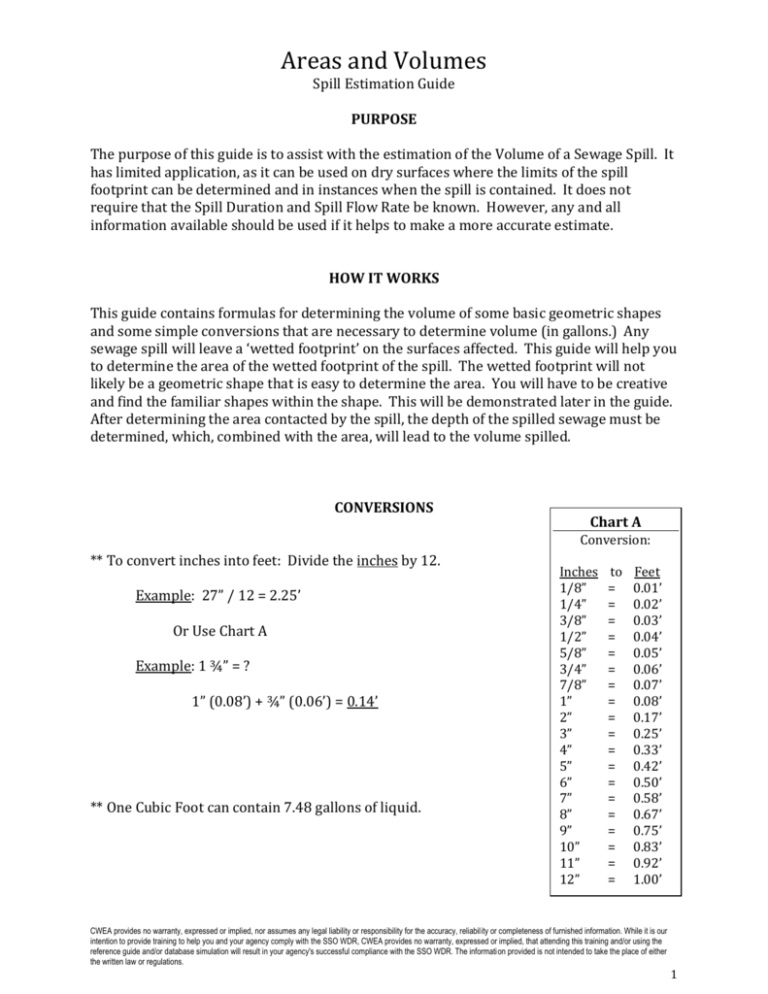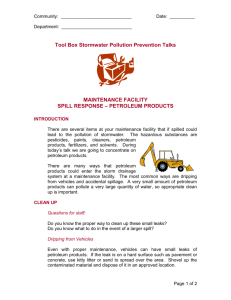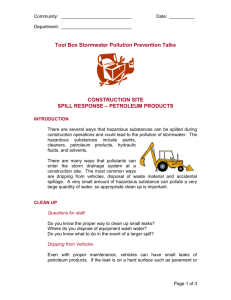Area and Volume
advertisement

Areas and Volumes Spill Estimation Guide PURPOSE The purpose of this guide is to assist with the estimation of the Volume of a Sewage Spill. It has limited application, as it can be used on dry surfaces where the limits of the spill footprint can be determined and in instances when the spill is contained. It does not require that the Spill Duration and Spill Flow Rate be known. However, any and all information available should be used if it helps to make a more accurate estimate. HOW IT WORKS This guide contains formulas for determining the volume of some basic geometric shapes and some simple conversions that are necessary to determine volume (in gallons.) Any sewage spill will leave a ‘wetted footprint’ on the surfaces affected. This guide will help you to determine the area of the wetted footprint of the spill. The wetted footprint will not likely be a geometric shape that is easy to determine the area. You will have to be creative and find the familiar shapes within the shape. This will be demonstrated later in the guide. After determining the area contacted by the spill, the depth of the spilled sewage must be determined, which, combined with the area, will lead to the volume spilled. CONVERSIONS Chart A Conversion: ** To convert inches into feet: Divide the inches by 12. Example: 27” / 12 = 2.25’ Or Use Chart A Example: 1 ¾” = ? 1” (0.08’) + ¾” (0.06’) = 0.14’ ** One Cubic Foot can contain 7.48 gallons of liquid. Inches 1/8” 1/4” 3/8” 1/2” 5/8” 3/4” 7/8” 1” 2” 3” 4” 5” 6” 7” 8” 9” 10” 11” 12” to = = = = = = = = = = = = = = = = = = = Feet 0.01’ 0.02’ 0.03’ 0.04’ 0.05’ 0.06’ 0.07’ 0.08’ 0.17’ 0.25’ 0.33’ 0.42’ 0.50’ 0.58’ 0.67’ 0.75’ 0.83’ 0.92’ 1.00’ CWEA provides no warranty, expressed or implied, nor assumes any legal liability or responsibility for the accuracy, reliability or completeness of furnished information. While it is our intention to provide training to help you and your agency comply with the SSO WDR, CWEA provides no warranty, expressed or implied, that attending this training and/or using the reference guide and/or database simulation will result in your agency's successful compliance with the SSO WDR. The information provided is not intended to take the place of either the written law or regulations. 1 Areas and Volumes Spill Estimation Guide GEOMETRY For the purposes of this guide, the unit of measurement will be in feet for formula examples. Area is two-dimensional - represented in square feet. (Length x Width) Volume is three-dimensional - represented in cubic feet. (Length x Width x depth) or (Diameter Squared) D2 x 0.785 x depth. A Note about Depth Wet Stain on a Concrete Surface - For a stain on concrete, use 0.0026’. This number is 1/32” converted to feet. For a stain on asphalt use 0.0013’ (1/64”). These were determined to be a reasonable depth to use on the respective surfaces through a process of trial and error. A known amount of water (one gallon) was poured onto both asphalt and concrete surfaces. Once the Area was determined as accurately as possible, different depths were used to determine the volume of the wetted footprint until the formula produced a result that (closely) matched the one gallon spilled. 1/32” was the most consistently accurate depth on concrete and 1/64” for asphalt. This process was repeated several times. Sewage “Ponding” or Contained – Measure actual depth of standing sewage whenever possible. When depth varies, measure several (representative) points, determine the average and use that number in your formula to determine volume. Area/Volume Formulas Area is two dimensional and is represented as Square Feet (SQ/FT) Volume is three dimensional and is represented as Cubic Feet (CU/FT) One Cubic Foot can hold 7.48 gallons CWEA provides no warranty, expressed or implied, nor assumes any legal liability or responsibility for the accuracy, reliability or completeness of furnished information. While it is our intention to provide training to help you and your agency comply with the SSO WDR, CWEA provides no warranty, expressed or implied, that attending this training and/or using the reference guide and/or database simulation will result in your agency's successful compliance with the SSO WDR. The information provided is not intended to take the place of either the written law or regulations. 2 Areas and Volumes Spill Estimation Guide AREA/VOLUME OF A RECTANGLE OR SQUARE Formula: Length x Width x Depth = Volume in Cubic Feet Chart A Conversion: 12’ Depth = 1 ¾” 25’ Length (25’) x Width (12’) x Depth (0.14’) 25’ x 12’ x 0.14’ = 42 Cubic Feet. Now the Volume in Cubic Feet is known. There are 7.48 Gallons in one Cubic Foot Inches 1/8” 1/4” 3/8” 1/2” 5/8” 3/4” 7/8” 1” 2” 3” 4” 5” 6” 7” 8” 9” 10” 11” 12” to = = = = = = = = = = = = = = = = = = = Feet 0.01’ 0.02’ 0.03’ 0.04’ 0.05’ 0.06’ 0.07’ 0.08’ 0.17’ 0.25’ 0.33’ 0.42’ 0.50’ 0.58’ 0.67’ 0.75’ 0.83’ 0.92’ 1.00’ So, 42 Cubic Feet x 7.48 gallons/cubic feet = 314 Gallons CWEA provides no warranty, expressed or implied, nor assumes any legal liability or responsibility for the accuracy, reliability or completeness of furnished information. While it is our intention to provide training to help you and your agency comply with the SSO WDR, CWEA provides no warranty, expressed or implied, that attending this training and/or using the reference guide and/or database simulation will result in your agency's successful compliance with the SSO WDR. The information provided is not intended to take the place of either the written law or regulations. 3 Areas and Volumes Spill Estimation Guide AREA/VOLUME OF A RIGHT TRIANGLE Chart A Conversion: Base x Height x 0.5 x Depth = Volume in Cubic Feet 10’ Depth = 5/8” 45’ Inches 1/8” 1/4” 3/8” 1/2” 5/8” 3/4” 7/8” 1” 2” 3” 4” 5” 6” 7” 8” 9” 10” 11” 12” to = = = = = = = = = = = = = = = = = = = Feet 0.01’ 0.02’ 0.03’ 0.04’ 0.05’ 0.06’ 0.07’ 0.08’ 0.17’ 0.25’ 0.33’ 0.42’ 0.50’ 0.58’ 0.67’ 0.75’ 0.83’ 0.92’ 1.00’ Base (45’) x Height (10’) x 0.5 x Depth (.05’) x 7.48 gallons/cubic foot = 84 gallons For Isosceles Triangles (two sides are equal lengths), Break it down into two Right Triangles and compute area as you would for the Right Triangle above. CWEA provides no warranty, expressed or implied, nor assumes any legal liability or responsibility for the accuracy, reliability or completeness of furnished information. While it is our intention to provide training to help you and your agency comply with the SSO WDR, CWEA provides no warranty, expressed or implied, that attending this training and/or using the reference guide and/or database simulation will result in your agency's successful compliance with the SSO WDR. The information provided is not intended to take the place of either the written law or regulations. 4 Areas and Volumes Spill Estimation Guide AREA/VOLUME OF A CIRCLE/CYLINDER D2 x 0.785 x d Diameter Squared x 0.785 x Depth = Volume in cubic feet. Diameter = Any straight line segment that passes through the center of a circle. For our purposes, it is the measurement across the widest part of a circle. D2 x 0.785 x depth = Volume in cubic feet Example: 27’ x 27’ x 0.785 x 0.03 = 17.17 cubic feet 17.17 cubic feet x 7.48 gallons/cubic feet = 128 gallons Chart - A Conversion: Inches to Feet 1/8” = 0.01’ 1/4” = 0.02’ 3/8” = 0.03’ 1/2” = 0.04’ 5/8” = 0.05’ 3/4” = 0.06’ 7/8” = 0.07’ 1” = 0.08’ 2” = 0.17’ 3” = 0.25’ 4” = 0.33’ 5” = 0.42’ 6” = 0.50’ 7” = 0.58’ 8” = 0.67’ 9” = 0.75’ 10” = 0.83’ 11” = 0.92’ 12” = 1.00’ Diameter = 27’ Depth = 3/8” CWEA provides no warranty, expressed or implied, nor assumes any legal liability or responsibility for the accuracy, reliability or completeness of furnished information. While it is our intention to provide training to help you and your agency comply with the SSO WDR, CWEA provides no warranty, expressed or implied, that attending this training and/or using the reference guide and/or database simulation will result in your agency's successful compliance with the SSO WDR. The information provided is not intended to take the place of either the written law or regulations. 5 Areas and Volumes Spill Estimation Guide Find the geometric shapes within the shape. If this was the shape of your spill, break it down, as best you can, with the shapes we know. 1. Determine the volumes of each shape. In this example, after the volume of the circle is determined, multiply it by 55% (+/-) so that the overlap area won’t be counted twice. 2. Add all the volumes to determine total spill volume. CWEA provides no warranty, expressed or implied, nor assumes any legal liability or responsibility for the accuracy, reliability or completeness of furnished information. While it is our intention to provide training to help you and your agency comply with the SSO WDR, CWEA provides no warranty, expressed or implied, that attending this training and/or using the reference guide and/or database simulation will result in your agency's successful compliance with the SSO WDR. The information provided is not intended to take the place of either the written law or regulations. 6 Areas and Volumes Spill Estimation Guide If the spill depth is of varying depths, take several measurements at different depths and find the average. 2” 1.5” 1.25” 1” 1.” 0.5” 0.75” 0.25” 2” + 1.5” + 1.25” + 1” + 1” + 0.75” + 0.5” + 0.25” = 8.25” 8.25” / 8 measurements = 1.03” Average Depth = 1.03” CWEA provides no warranty, expressed or implied, nor assumes any legal liability or responsibility for the accuracy, reliability or completeness of furnished information. While it is our intention to provide training to help you and your agency comply with the SSO WDR, CWEA provides no warranty, expressed or implied, that attending this training and/or using the reference guide and/or database simulation will result in your agency's successful compliance with the SSO WDR. The information provided is not intended to take the place of either the written law or regulations. 7 Areas and Volumes Spill Estimation Guide NOTE: This can be used in a (Dry) dirt or grassy area that is not regularly irrigated like a field or a dirt parking lot. Step 1 If the spill affects a dry, unimproved area such as a field or dirt parking lot, determine the Area of the wetted ground in the same manner as you would on a hard surface. Using a roundpoint shovel, dig down into the soil until you find dry soil. Do this in several locations within the wetted area and measure the depth of the wet soil. Average the measurement/thickness of the wet soil and determine the average depth of the wet soil. Wet weather would make this method ineffective. 2” 1.5” 1.25” 3” Step 2 Take a Test Sample ( See Next Page) 5” 1.25” EXAMPLE: If the Area of the spill was determined to be 128 Sq/Ft and the average depth of the wet soil is 2.33 inches: 2” + 1.5” + 1.25” + 3” + 5” + 1.25” = 14.0” 14.0” / 6 measurements = 2.33” 128 Sq/Ft x 0.194’ = 24.83 Cu/Ft 24.83 Cu/Ft x 7.48 Gals/Cu/Ft = 185.74 gallons 185.74 x 18% = 33 Gallons (water in soil) Average Depth = 2.33” (0.194’) CWEA provides no warranty, expressed or implied, nor assumes any legal liability or responsibility for the accuracy, reliability or completeness of furnished information. While it is our intention to provide training to help you and your agency comply with the SSO WDR, CWEA provides no warranty, expressed or implied, that attending this training and/or using the reference guide and/or database simulation will result in your agency's successful compliance with the SSO WDR. The information provided is not intended to take the place of either the written law or regulations. 8 Areas and Volumes Spill Estimation Guide (Test) SAMPLING SOIL FOR WATER CONTENT Once you have determined the wetted footprint of the spill, you will want to determine the water (sewage) content in the soil. 1. Select an area of dry soil (near the wetted footprint of the spill) to sample. 2. Pour a known amount of water onto the soil and let it soak in for an adequate amount of time. If possible, use a form to keep the water contained to a geometric shape (circle, square, rectangle, etc.). 3. Determine the Area of the wetted footprint. 4. Using a small hand tool, dig down into the soil until dry soil is reached. Measure the depth of the wet soil. Do this in multiple locations and average the measurements. 5. Multiply the Area by the Average Depth of the wet soil to determine the volume of the wet soil. 6. Determine the water content in the soil a. Since you started with a known amount, you know how much water is in the soil. b. Divide that known amount by the volume determined in step 5 to arrive at the percent of water content in the soil. c. Arrive at the water content of the soil (percent) Example: 1. Place a 2-foot diameter form onto an area of dry soil. 2. Pour one gallon of water into the form and let it soak in for 15 minutes. 3. Pull the form and measure the Area of the wetted soil (it will likely be larger than the form). Let’s say 26” diameter. 4. Dig into the soil in 3 locations and measure the depth of the wetted soil. 5. Average the 3 measurements. (Let’s say 2.5”, 1.5” & 3.75” = 7.75”. divide by 3 = 2.58” or 0.215’) 6. Determine the Area of the Circle (D2 x 0.785) 2.16’ x 2.16’ x 0.785 = 3.66 Sq/Ft 7. Multiply the Area by the Average Depth to get the Volume (3.66 x 0.215’ = 0.79 Cu/Ft) 8. Multiply 0.79 cubic feet by 7.48 gallons/Cu/ft = 5.9 gallons. 9. Divide 1 Gallon (known Amount) by 5.9 gallons = .17 or 17% is the water content in the soil. 10. Now you have determined that the water content in the soil is 17%. Apply this to your actual spill area. CWEA provides no warranty, expressed or implied, nor assumes any legal liability or responsibility for the accuracy, reliability or completeness of furnished information. While it is our intention to provide training to help you and your agency comply with the SSO WDR, CWEA provides no warranty, expressed or implied, that attending this training and/or using the reference guide and/or database simulation will result in your agency's successful compliance with the SSO WDR. The information provided is not intended to take the place of either the written law or regulations. 9







